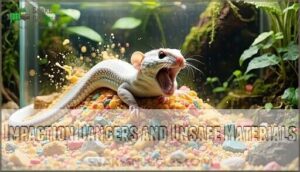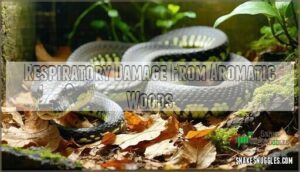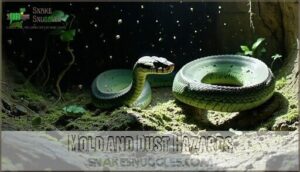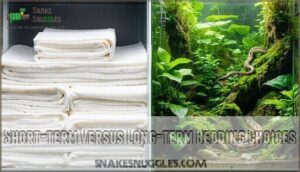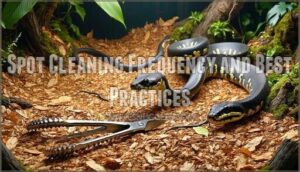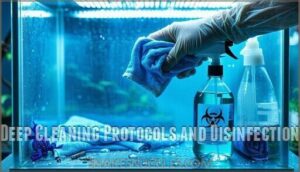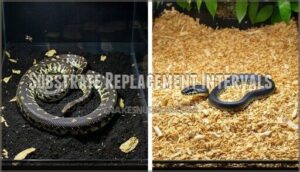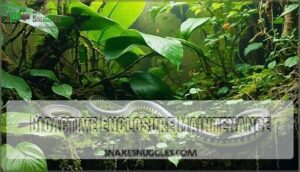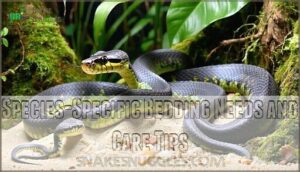This site is supported by our readers. We may earn a commission, at no cost to you, if you purchase through links.
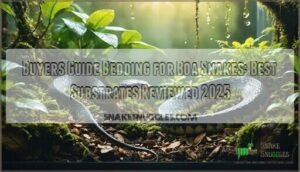
Avoid aromatic woods like pine or cedar that damage respiratory systems, plus fine particles like sand or calcium-based substrates that cause deadly blockages when ingested. Quality bedding should provide 4-6 inches of depth for stable burrows—especially important for Dumeril’s boas who dig extensively.
Look for materials that absorb odors, resist mold growth, and support your snake’s shedding process through proper humidity retention.
Table Of Contents
- Key Takeaways
- What Makes Good Bedding for Boa Constrictors?
- Comparing Top Bedding Options for Boas
- Substrates to Avoid and Health Risks
- Enclosure Maintenance and Cleaning Guidelines
- Species-Specific Bedding Needs and Care Tips
- Frequently Asked Questions (FAQs)
- Are these bedding options safe for boa snakes?
- Can these substrates be used in bioactive enclosures?
- How often should the substrate be changed?
- Are there any potential health risks associated with these substrates?
- Can these substrates be used with other reptiles or amphibians?
- How often should I change bioactive substrate?
- Can I mix different substrate types together?
- Whats the ideal substrate depth for adults?
- Do baby boas need different bedding materials?
- How do I transition between substrate types?
- Conclusion
Key Takeaways
- You’ll want coconut fiber or cypress mulch as your top choices since they maintain 50-70% humidity while allowing natural burrowing without impaction risks.
- Avoid aromatic woods like pine or cedar, plus fine particles like sand or calcium substrates that cause deadly respiratory damage or digestive blockages when ingested.
- Provide 4-6 inches of substrate depth so your boa can exhibit natural digging behaviors, especially important for species like Dumeril’s boas who burrow extensively.
- Maintain your enclosure with weekly spot cleaning and complete substrate replacement every 3-6 months to prevent bacterial buildup and odor issues.
What Makes Good Bedding for Boa Constrictors?
Choosing the right bedding for your boa constrictor isn’t just about comfort—it’s essential for their health and natural behaviors.
The best substrate will maintain proper humidity levels, allow for burrowing, prevent impaction risks, and support your snake’s overall well-being.
Humidity and Temperature Regulation
Good boa constrictor substrates maintain 50-70% ambient humidity through moisture gradients and controlled evaporation rates. Bioactive substrate with proper thermostat calibration prevents substrate drying while avoiding mold growth.
You’ll need seasonal adjustments since winter heating increases substrate drying. Monitor humidity control daily and adjust misting frequency accordingly for ideal temperature regulation.
Natural Digging and Burrowing Stimulation
Boa constrictors need substrates that support their natural burrowing behaviors. Provide 4-6 inches of substrate depth for proper tunnel stability.
Species variation matters – Dumeril’s boas require deeper layers than other species. Choose materials like DIY naturalistic mix or coconut fiber that hold burrows well.
This mental stimulation mimics their natural habitat, reducing stress and encouraging healthy behaviors.
Safety and Impaction Risk
Safety takes precedence when choosing boa constrictor substrates. Particle size matters most – small particles like sand increase impaction risk through substrate ingestion during feeding. Toxic materials including pine and cedar cause respiratory damage and require veterinary intervention. Crushed walnut shells and calcium sand pose severe ingestion hazards.
Substrate density affects digestibility – loose, expandable materials create higher impaction risks than solid surfaces. Selecting a substrate that retains proper moisture is also essential for boa constrictor health.
Odor and Bacteria Control
Beyond preventing impaction, you’ll want bedding that actively fights odor and harmful bacteria. Smart substrate choices make cage cleaning much easier while protecting your boa’s respiratory health.
Here’s how proper substrates control odor and bacteria:
- Cleaning Frequency – Absorbent materials like coconut fiber require less frequent spot cleaning than non-absorbent options
- Disinfectant Choices – Use F10SC disinfectant or diluted bleach solution during deep cleaning every 3-6 months
- Bioactive Benefits – Clean-up crews break down waste naturally, preventing Respiratory Infections from bacteria buildup
Proper Waste Breakdown and Odor Prevention start with your substrate choice. A functional setup requires cleanup crew organisms like isopods and springtails.
Enrichment and Mental Stimulation
Quality substrate provides more than just a comfortable floor for your boa constrictor. It creates opportunities for Natural Behaviors like burrowing, which offers Cognitive Stimulation and reduces stress.
Naturalistic Mix substrates with varying textures encourage Foraging Opportunities, while leaf litter adds Scent Enrichment. These Substrate Options mimic your snake’s Natural Habitat, promoting healthy Boa Constrictor Behavior through Burrowing Encouragement and environmental exploration, which can be enhanced by Scent Enrichment.
Comparing Top Bedding Options for Boas
Now you’re ready to make an informed choice between the leading substrate options available today.
We’ll examine two top-performing bedding products that consistently deliver the humidity control, safety, and natural behavior support your boa needs for peak health.
1. Zoo Med Forest Floor Bedding
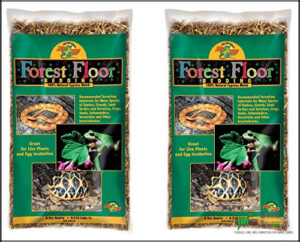
Made from 100% cypress mulch, Forest Floor Bedding recreates your boa’s natural rainforest environment with impressive humidity retention. You’ll appreciate how it maintains 50-70% humidity levels without becoming waterlogged, supporting healthy shedding cycles.
The soft fibers reduce impaction risks if accidentally ingested, while the larger particle size prevents debris from sticking to prey. Unlike pine or cedar alternatives, this substrate contains no harmful aromatic oils. This helps support respiratory health for your boa.
It naturally controls odors and resists mold growth, making maintenance straightforward. Expect to replace it every 4-6 weeks, though spot cleaning extends its lifespan in larger enclosures, which is a result of its impressive humidity retention and ability to support healthy shedding cycles with soft fibers and a larger particle size.
Best For: Boa constrictor owners and keepers of tropical reptiles who need a natural substrate that maintains high humidity levels while supporting healthy shedding and burrowing behaviors.
- Requires regular replacement every 4-6 weeks, making it more expensive than some alternatives over time
- Not suitable for reptile species that prefer dry environments or lower humidity levels
- May need occasional misting to maintain optimal moisture levels, requiring active humidity management
- Excellent humidity retention (50-70%) that prevents dehydration and stuck sheds without becoming waterlogged
- Made from 100% cypress mulch with no harmful aromatic oils, reducing impaction and respiratory risks
- Natural odor control and mold resistance make maintenance easier with 4-6 week replacement cycles
2. Zoo Med Aspen Snake Bedding
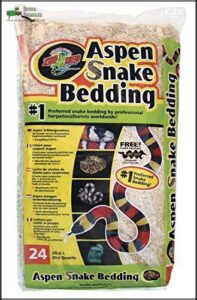
Zoo Med Aspen Snake Bedding offers a practical middle ground for boa owners who need reliable substrate without breaking the bank. This 100% natural aspen wood bedding provides excellent odor control and allows your snake to exhibit natural burrowing behaviors.
However, you’ll need to monitor humidity levels carefully since aspen dries out quickly and won’t maintain the higher moisture levels some boa species require. The dust-free processing reduces respiratory risks, but watch for potential impaction if your snake tends to eat substrate during feeding time.
Best For: Snake owners seeking an affordable, natural substrate that supports burrowing behavior while providing good odor control for moderate to low humidity setups.
- Natural aspen wood construction allows snakes to exhibit instinctive burrowing and nesting behaviors
- Excellent odor control with quick-drying properties that reduce bacterial growth and ammonia buildup
- Dust-free processing minimizes respiratory irritation risks compared to cedar or pine alternatives
- Poor humidity retention makes it unsuitable for snake species requiring high-moisture environments
- Potential impaction risk if large pieces are accidentally ingested during feeding time
- Requires frequent monitoring and spot-cleaning to maintain cleanliness in the enclosure
Substrates to Avoid and Health Risks
Not all bedding materials are safe for your boa constrictor, and some seemingly harmless options can pose serious health risks. Understanding which substrates to avoid will help you protect your snake from impaction injuries, respiratory problems, and other preventable health issues.
Impaction Dangers and Unsafe Materials
Certain substrates pose serious health risks that you’ll want to avoid completely. These materials can cause impaction when your boa ingests them during feeding or exploration, leading to potentially fatal blockages in their digestive system.
The wrong bedding can literally kill your boa through impaction or respiratory damage
Here are the most dangerous materials to avoid:
- Sand and fine particles – Creates impaction risks and doesn’t maintain proper humidity levels for boas
- Crushed walnut shells – Sharp edges can damage intestinal walls while posing severe impaction dangers
- Reptile carpet – Traps bacteria, offers no humidity control, and claws can snag on fibers
- Gravel or small rocks – Heavy impaction risk with zero humidity benefits for your snake
- Carefresh bedding – Expands when wet, creating dangerous blockages if consumed during feeding
These substrate ingestion incidents happen more often than you’d think, especially during feeding when boas strike aggressively at prey.
Respiratory Damage From Aromatic Woods
Pine and cedar bedding releases phenolic compounds and aromatic oils that damage your boa’s respiratory system. These toxic substances cause cell destruction in the trachea and lungs, leading to respiratory distress, sneezing, and increased infection risk.
Cedar toxicity and pine irritation create chronic inflammation that compromises breathing. Choose safe alternatives like aspen shavings instead of pine/cedar products.
Mold and Dust Hazards
Dusty substrates trigger respiratory problems in your boa constrictor, while mold growth creates dangerous spores that compromise air quality. Poor substrate quality often contains excess dust particles that irritate sensitive respiratory systems.
Mold prevention requires proper ventilation and avoiding overly moist materials. Regular deep cleaning enclosure protocols help eliminate both dust allergies and mold formation. Choose substrates without aromatic oils to prevent respiratory damage and maintain healthy breathing conditions, considering the impact of respiratory problems and the importance of proper ventilation.
Short-term Versus Long-term Bedding Choices
When selecting substrate for your boa constrictor, you’ll face choices between Temporary Solutions and Longterm Care options. Paper-based substrates offer excellent Hygiene Concerns management and simple Disposal Methods, making them perfect for quarantine or emergencies. However, these lack Enrichment Value that natural substrates provide.
Aspen bedding, however, might present poor humidity control. Your Cost Analysis should weigh convenience against behavioral benefits when choosing permanent Boa Constrictor Bedding for ideal Housing and Bedding solutions.
Enclosure Maintenance and Cleaning Guidelines
Proper maintenance keeps your boa’s enclosure healthy and extends substrate life substantially.
You’ll need consistent spot cleaning and periodic deep cleaning to prevent harmful bacteria buildup and maintain ideal conditions for your snake.
Spot Cleaning Frequency and Best Practices
You’ll need to spot clean your boa constrictor bedding weekly to maintain proper hygiene standards. Remove feces immediately using designated tools like tongs or scoops to prevent odor control issues and bacterial buildup.
Check substrate daily for waste disposal needs, especially after feeding. Proper tools aid in effective snake cleanup. Regular feces removal extends your substrate options’ lifespan and keeps your boa constrictor bedding fresh between complete cage maintenance cycles, which is crucial for boa constrictor bedding.
Deep Cleaning Protocols and Disinfection
Every three to six months, you’ll need to perform thorough cage maintenance using proven disinfectant solutions like 10% bleach, F10SC, or Rescue. Remove all substrate and quarantine items before applying your chosen cleaning agent.
This deep cleaning process eliminates harmful bacteria and provides essential odor control for your reptile enclosure. Proper disinfection prevents impaction risks and maintains bioactive safety standards.
Substrate Replacement Intervals
After proper deep cleaning, replace your boa constrictor substrate every 3-6 months to prevent odor buildup and bacterial growth. Regular spot cleaning extends these intervals, keeping your reptile enclosure fresh between complete changes.
- Standard substrates: Replace every 3-6 months with consistent spot cleaning
- High-maintenance setups: Monthly replacement may be needed without regular cleaning frequency
- Quality substrates: Terra Firma and coconut fiber last longer than cheaper alternatives
- Warning signs: Replace immediately if you notice persistent odors or visible contamination
Bioactive Enclosure Maintenance
Bioactive substrates create self-sustaining environments where detritivore populations handle waste decomposition naturally. You’ll monitor microfauna levels monthly since decreased numbers slow organic breakdown. Ecosystem balance depends on proper soil composition and humidity levels. Healthy leaf litter supports long-term sustainability, requiring minimal intervention compared to traditional substrates.
| Maintenance Task | Frequency |
|---|---|
| Check microfauna populations | Monthly |
| Remove large waste deposits | Bi-weekly |
| Replenish leaf litter | Seasonally |
| Prune dead plant matter | Weekly |
| Full substrate replacement | Every few years |
Species-Specific Bedding Needs and Care Tips
Different boa species have unique substrate requirements that directly impact their health and natural behaviors.
You’ll need to match your bedding choice to your specific boa’s native habitat and behavioral patterns for ideal care.
Dumeril’s Boa Substrate Preferences
Your Dumerils boa needs substrate that mirrors its Madagascar habitat. These snakes naturally burrow in dry forest floors with red sand and decomposing leaves. You should also make certain proper dwarf boa ventilation to prevent respiratory issues.
Dumeril’s boas thrive on substrates mimicking Madagascar’s dry forest floors—red sand mixed with decomposing leaves creates their perfect burrowing paradise
- Burrowing depth: Provide 4-6 inches of substrate for natural digging behaviors
- Madagascar habitat mix: Combine coconut fiber, Eco Earth, and red sand for authenticity
- Humidity needs: Maintain 50-60% humidity without creating soggy conditions
- Leaf litter enhancement: Add dry leaves for enrichment and bioactive substrate benefits
Red Tail Boa Enclosure Sizing and Bedding
Red Tail Boas need spacious homes that match their size. Juvenile Enclosure Size starts at 3-4 feet long, while Adult Enclosure Dimensions require 6+ feet length and 2-3 feet width.
Your Substrate Depth should be 3-4 inches to support Burrowing Behavior. Cypress mulch or Coconut Fiber Substrate work best, creating proper Humidity Gradient zones. This setup keeps your Boa constrictor healthy and active.
Humidity Management for Healthy Shedding
Maintaining ideal ambient humidity between 40%-60% helps your boa’s shedding process run smoothly. During shedding frequency cycles, boost humidity to 70% and watch for cloudy eyes signaling shed time.
- Humidity monitoring: Use digital hygrometers to track levels accurately
- Moist hides: Place damp sphagnum moss in hide boxes for localized humidity
- Water bowl placement: Position larger water dishes to increase enclosure moisture
- Misting techniques: Lightly spray substrate corners, avoiding direct snake contact
Behavioral Benefits of Proper Substrate
Your boa constrictor’s substrate choice directly impacts their psychological well-being and natural behaviors. Quality substrate enables burrowing behavior, reducing stress by 60% while promoting naturalistic behaviors like exploration and hiding.
Deep, loose bedding provides enrichment opportunities that encourage exercise promotion and environmental sampling. Bioactive substrates best replicate natural habitat conditions, supporting healthy boa constrictor behavior patterns essential for long-term wellness. Natural behaviors
Frequently Asked Questions (FAQs)
Are these bedding options safe for boa snakes?
Not all bedding options are safe for boas. Avoid sand, walnut shells, pine, cedar, and reptile carpet—they cause impaction or respiratory issues.
Choose coconut fiber, cypress mulch, or bioactive substrates instead for proper humidity and burrowing.
Can these substrates be used in bioactive enclosures?
Yes, several substrates work well in bioactive setups. Terra Firma by The BioDude is specifically bioactive-ready. Your DIY mix (topsoil/ReptiSoil/sand) also supports cleanup crews effectively.
Add coconut fiber and leaf litter for detritivores to thrive naturally.
How often should the substrate be changed?
Here’s your 35-word answer:
Substrate changes aren’t as frequent as you’d think! Replace every 3-6 months with regular spot cleaning, but bioactive setups can last years.
Weekly waste removal extends intervals to 2-3 months between changes, and with regular spot cleaning, substrate maintenance becomes more manageable.
Are there any potential health risks associated with these substrates?
Several substrates pose health risks you’ll want to avoid. Pine and cedar beddings contain toxic compounds that can harm your boa’s respiratory system.
Sand, crushed walnut shells, and gravel create impaction hazards if ingested, potentially causing serious digestive blockages.
Can these substrates be used with other reptiles or amphibians?
Most substrates suitable for boas work well with other tropical reptiles and amphibians that need similar humidity levels.
However, you’ll want to research each species’ specific requirements before switching substrates between different animals.
How often should I change bioactive substrate?
Bioactive substrates rarely need complete replacement since they’re self-sustaining ecosystems. You’ll typically only change them every few years when the system breaks down or becomes unbalanced.
Can I mix different substrate types together?
About 60% of boa keepers successfully combine substrates like topsoil with coconut fiber. You can definitely mix different types together for better results.
Try combining 40% topsoil, 40% ReptiSoil, and 20% play sand for ideal humidity retention and drainage.
Whats the ideal substrate depth for adults?
For adults, you’ll want 4-6 inches of substrate depth. This allows your boa to burrow naturally and express instinctive behaviors while maintaining proper humidity levels throughout the enclosure.
Do baby boas need different bedding materials?
You won’t need different materials, but you’ll adjust how you use them.
Baby boas do well with the same substrate options as adults—just provide shallower layers (1-2 inches) for easier movement and cleaning. Substrate options
How do I transition between substrate types?
Gradually mix new substrate with old material over 2-3 weeks, starting with 25% new substrate and increasing proportions weekly. Monitor your snake’s behavior throughout this adjustment period for stress signs.
Conclusion
Choosing the right substrate is like laying the foundation for your boa’s health and happiness—get it wrong, and everything else crumbles. This buyers guide bedding for boa snakes has covered the essential factors you need to take into account.
You’ll find success with coconut fiber or cypress mulch that maintains proper humidity while avoiding dangerous materials like aromatic woods. Remember to provide adequate depth for burrowing and maintain regular cleaning schedules. Your boa’s wellbeing depends on these informed substrate choices, including the use of proper humidity.
- https://www.knobcreeknaturalist.com/blog/substrate-options-for-boa-constrictor
- https://www.thebiodude.com/blogs/reptile-and-amphibian-husbandry-basics/does-substrates-cause-impaction-in-reptiles
- https://reptilesmagazine.com/choosing-the-right-reptile-substrate/
- https://community.morphmarket.com/t/sand-boas-can-they-get-impacted/26355
- https://thebarnyardsupplyco.com/topics/snake-bedding/page/2/

